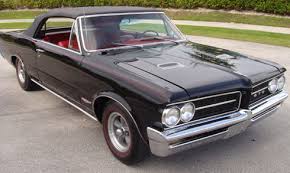I was still several years shy of legally driving when this was published, but I read the magazine every month, and when September came-around every year, I made my Dad take me to the local new car showrooms to see the latest cars.
This was a real 'finger in the eye' to the imported cars of the time which were classed as 'performance cars,' because the very idea that a car company primarily known for extolling its "Wide-track" look instead of an extreme number of cylinders, Weber carbs, and hand-formed body panels in steel and aluminum, could even be mentioned in the same breath much-less actually beat one of these European sports cars, was heresy of the highest order. "Surrender your string-backed driving gloves, right-now! "
http://www.caranddriver.com/reviews/pontiac-tempest-gto-archived-road-test
Here is one of the articles which put Car and Driver on the map, journalistically-speaking. The fact that they dared to take on Ferrari with a MI-built production car was hard for many people to swallow. Was it prepped by Royal Bobcat of Lansing MI? Did it bear some cheater mods to enhance its performance? So-what? It shook-up the establishment, and motor-journalism was never really the same. Read the article, and see for yourself what the furor was all-about.
The fact that today, nearly 50 years later, this article is still remembered, and spoken-of, means that it will probably outlast Kanye West in popularity, relevance, and influence. No Sex-tape Mamma required!:rofl_200:


Yeah, I know, Nick Mason has two, and they're worth $20,000,000+ apiece, but if you owned a Ferrari GTO, would you dare to drive it on the street, knowing the texting, makeup-applying, cellphone using idiots allowed to operate a 5000 lb 350 hp SUV-bomb?
This was a real 'finger in the eye' to the imported cars of the time which were classed as 'performance cars,' because the very idea that a car company primarily known for extolling its "Wide-track" look instead of an extreme number of cylinders, Weber carbs, and hand-formed body panels in steel and aluminum, could even be mentioned in the same breath much-less actually beat one of these European sports cars, was heresy of the highest order. "Surrender your string-backed driving gloves, right-now! "
http://www.caranddriver.com/reviews/pontiac-tempest-gto-archived-road-test
Here is one of the articles which put Car and Driver on the map, journalistically-speaking. The fact that they dared to take on Ferrari with a MI-built production car was hard for many people to swallow. Was it prepped by Royal Bobcat of Lansing MI? Did it bear some cheater mods to enhance its performance? So-what? It shook-up the establishment, and motor-journalism was never really the same. Read the article, and see for yourself what the furor was all-about.
The fact that today, nearly 50 years later, this article is still remembered, and spoken-of, means that it will probably outlast Kanye West in popularity, relevance, and influence. No Sex-tape Mamma required!:rofl_200:
Yeah, I know, Nick Mason has two, and they're worth $20,000,000+ apiece, but if you owned a Ferrari GTO, would you dare to drive it on the street, knowing the texting, makeup-applying, cellphone using idiots allowed to operate a 5000 lb 350 hp SUV-bomb?



















![Bovemanx Motorcycle Phone Mount Holder, [150mph Wind Anti-Shake][7.2inch Big Phone Friendly] Bike Phone Holder, Motorcycle Handlebar Cell Phone Clamp, Compatible with iPhone 16 Pro Max Smartphones](https://m.media-amazon.com/images/I/51F+1sontPL._SL500_.jpg)




















![Lamicall Motorcycle Phone Mount Holder - [Dual Vibration Dampener] [720° Adjustment Arm] Motorcycle Cell Phone Holder, Bike Handlebar Phone Mount, for iPhone 16/15/ 14/13 Pro Max, 4.7-6.7" Phones](https://m.media-amazon.com/images/I/41g9IDInCIL._SL500_.jpg)






